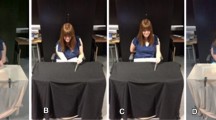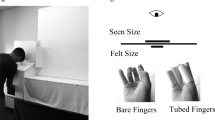Abstract
An experiment was designed to investigate haptic perception of length depending on whether inputs were cutaneous or derived from passively-guided movements. Cutaneous inputs appeared to offer more accurate information than did those from kinesthesis. Our results are inconsistent with the view that, for identification of raised line drawings, kinesthetic inputs are more important than tactile inputs.
Access this chapter
Tax calculation will be finalised at checkout
Purchases are for personal use only
Preview
Unable to display preview. Download preview PDF.
Similar content being viewed by others
References
Bergmann Tiest, W.M., van der Hoff, L.M., Kappers, A.M.: Cutaneous and kinaesthetic perception of traversed distance. In: Proceedings of the IEEE World Haptics Conference, pp. 593–597 (2011)
Jansson, G.: Haptic perception of outline 2d shape: The contributions of information via the skin, the joints and the muscles. In: Bril, B., Ledebt, A., Dietrich, G., Roby-Brami, A. (eds.) Advances in Perception - Action Coupling, pp. 25–30. Editions EDK, Paris (1998)
Noll, N.C., Weber, R.J.: Visual and tactile scanning: moving scan versus moving medium. Bulletin of the Psychonomic Society 23, 473–476 (1985)
Magee, L.E., Kennedy, J.M.: Exploring pictures tactually. Nature 283, 287–288 (1980)
Gibson, J.J.: Observations on active touch. Psychological Review 69(6), 477–490 (1962)
Srinivasan, M.A., LaMotte, R.H.: Tactual discrimination of softness. Journal of Neurophysiology 73, 88–101 (1995)
Giachritsis, C., Wright, R., Wing, A.: The Contribution of Proprioceptive and Cutaneous Cues in Weight Perception: Early Evidence for Maximum-Likelihood Integration. In: Kappers, A.M.L., van Erp, J.B.F., Bergmann Tiest, W.M., van der Helm, F.C.T. (eds.) EuroHaptics 2010, Part I. LNCS, vol. 6191, pp. 11–16. Springer, Heidelberg (2010)
Ernst, M.O., Banks, M.S.: Humans integrate visual and haptic information in a statistically optimal fashion. Nature 415, 429–433 (2002)
Symmons, M.A., Richardson, B.L., Wuillemin, D.B.: Components of haptic information: skin rivals kinesthesis. Perception 37, 1596–1604 (2008)
Richardson, B.L., Symmons, M.A., Wuillemin, D.B.: The relative importance of cutaneous and kinesthetic cues in raised line drawing exploration. In: Ballesteros, S., Heller, M.A. (eds.) Touch, Blindness, and Neuroscience, pp. 247–250. Universidad Nacional de Educacion a Distancia, Madrid (2004)
Aron, A., Gabrieli, J., Hedden, T., Ketay, S., Markus, H.: Cultural influences in neural substrates of attentional control. Psychological Science 19(1), 12–17 (2008)
Richardson, B.L., Symmons, M.A., Accardi, R.: The TDS: a new device for comparing active and passive-guided touch. IEEE Transactions on Rehabilitation Engineering 8, 414–417 (2000)
Loo, C.K., Hall, L.A., McCloskey, D.I., Rowe, M.J.: Proprioceptive contributions to tactile identification of figures: dependence on figure size. Behavioural Brain Research 7(3), 383–386 (1983)
Author information
Authors and Affiliations
Editor information
Editors and Affiliations
Rights and permissions
Copyright information
© 2012 Springer-Verlag Berlin Heidelberg
About this paper
Cite this paper
Van Doorn, G.H., Richardson, B.L., Symmons, M.A., Howell, J.L. (2012). Cutaneous Inputs Yield Judgments of Line Length That Are Equal to, or Better Than, Those Based on Kinesthetic Inputs. In: Isokoski, P., Springare, J. (eds) Haptics: Perception, Devices, Mobility, and Communication. EuroHaptics 2012. Lecture Notes in Computer Science, vol 7283. Springer, Berlin, Heidelberg. https://doi.org/10.1007/978-3-642-31404-9_5
Download citation
DOI: https://doi.org/10.1007/978-3-642-31404-9_5
Publisher Name: Springer, Berlin, Heidelberg
Print ISBN: 978-3-642-31403-2
Online ISBN: 978-3-642-31404-9
eBook Packages: Computer ScienceComputer Science (R0)




